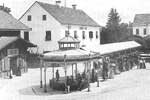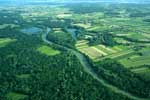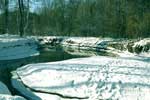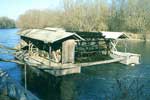      

|

Waters
  Mineral
water springs Mineral
water springs
The story of the health resort Radenci is
the story of water that has been determining the fate of inhabitants of Radenci
and its vicinity and has taken the name Radenci
in the form of three hearts into the world.
A student of medicine in Vienna, Karl Henn, was travelling to Ljutomer by coach
in 1833 when he saw the miraculous water in the marshy meadows in the Radenci
surroundings, which the locals called "bublja". Upon having examined
the springs thoroughly he established that they literally boil and that bubbles
are raised during the process. 32 years later he returned to Radenci again and
because no one was exploiting the wells at that time he, as a distinguished physician
and an expert for balneology, the science of healing waters, decided to buy the
piece of land and capture the miracle spring.
 In
1869 his efforts paid off and the first mineral water flew through the oak pipe
from 17 m deep. Henn named this mineral water Radeiner
Sauerbrunn and built a
reservoir above the spring. Proof that the experts too were aware of mineral
water from Radenci can be found in an article, published in 1872 in the Vienna
Yearbook for balneology, hydrology and climatology by professor Kisch - one of
the leading experts-balneologists of his time.
Unfortunately illness prevented him from realizing his dream of a health resort
and he died at the age of 67, presumably of kidney cancer. In
1869 his efforts paid off and the first mineral water flew through the oak pipe
from 17 m deep. Henn named this mineral water Radeiner
Sauerbrunn and built a
reservoir above the spring. Proof that the experts too were aware of mineral
water from Radenci can be found in an article, published in 1872 in the Vienna
Yearbook for balneology, hydrology and climatology by professor Kisch - one of
the leading experts-balneologists of his time.
Unfortunately illness prevented him from realizing his dream of a health resort
and he died at the age of 67, presumably of kidney cancer.
  The
Mura river The
Mura river
The beautiful river Mura features interesting fauna and flora in its
rapids. Mura is mainly a lowland river covering a distance of 95 km
in Slovenia which makes it one of the longest rivers we have. Its source
is in Austria in Niedrige Tauern and there it is named Mur. As it does
partly now it served as a border river in the past. From the 13th century
until the First World War it served as a border river between Austria
and Hungary which is also the main reason for the differences between
the people on the left and the right bank. The difference is easiest
to notice if you visit the Prleki people and the Prekmurci people separately.
There are differences not only in customs and habits, but also in nutrition
and, above all, dialect. You can pick up certain expressions fairly
quickly when talking with the locals who are very hospitable on both
banks of Mura and note the differences yourself. Once Mura served millers
and turned the wheels in their mills, but it is obvious that this profession
is now dying off. There were around 40 floating mills on the river
as late as the beginning of the 20th century, but few are still around
today. Nowadays they are being restored and offered as a trip to the
past. Of course you can enjoy the walk on the Path along Mura and relish
the most interesting plants growing here in lethargies and marshes.
 
Climate
Pomurje has subpannonial climate with
great temperature differences between summer and winter, there are
relatively few rainfalls which are more frequent in the vegetation
season.
The microclimate of Radenci has been studied and it has been established
that it has a favourable effect on human beings during treatment and
recreation. On average, Radenci has 850 mm of rain per year, only 12
foggy days and the wind rarely exceeds 4 Beaufort. The average number
of sun hours per year (1785) is 25 to 45 percent higher than in the
depressions of central Slovenia. Optimum bioclimatic conditions last
from the beginning of May to mid October, with the exception of hot
and sultry summer days which are toned down by frequent crossings of
thunderstorms. The microclimate of Radenci is soothing, has a positive
effect on treatment, rehabilitation and recreation of patients; and
it also helps healthy people increase their body resistance.
 the
stream in Boračeva the
stream in Boračeva
 gravels in Hrastje
Mota gravels in Hrastje
Mota
 wells wells
 the stream in
Radenci the stream in
Radenci
Woods
 park park
 trim track trim track
 meadow meadow
 grove grove
Hills
 Kapela Kapela
 Janžev Vrh Janžev Vrh |



